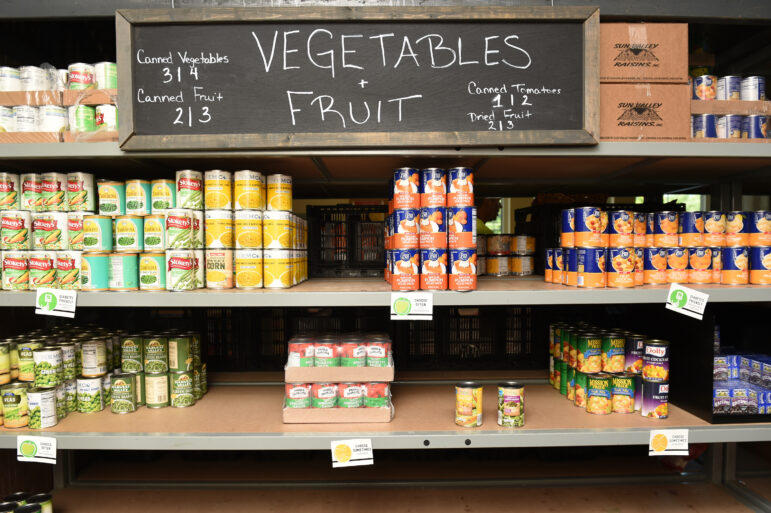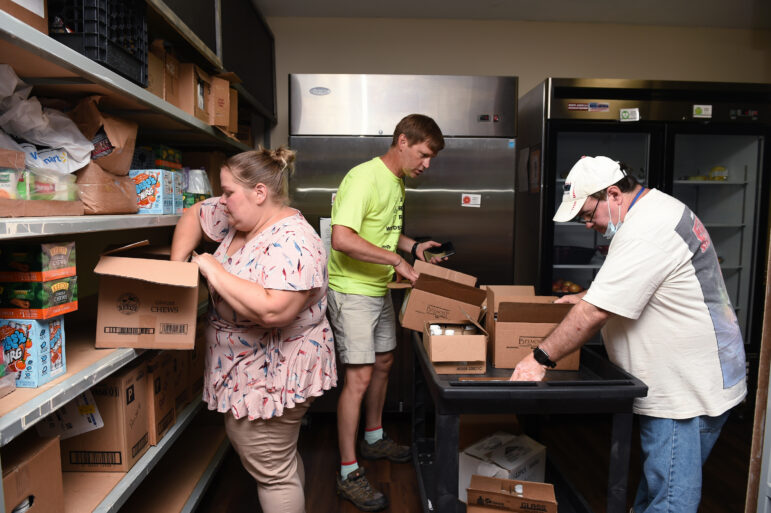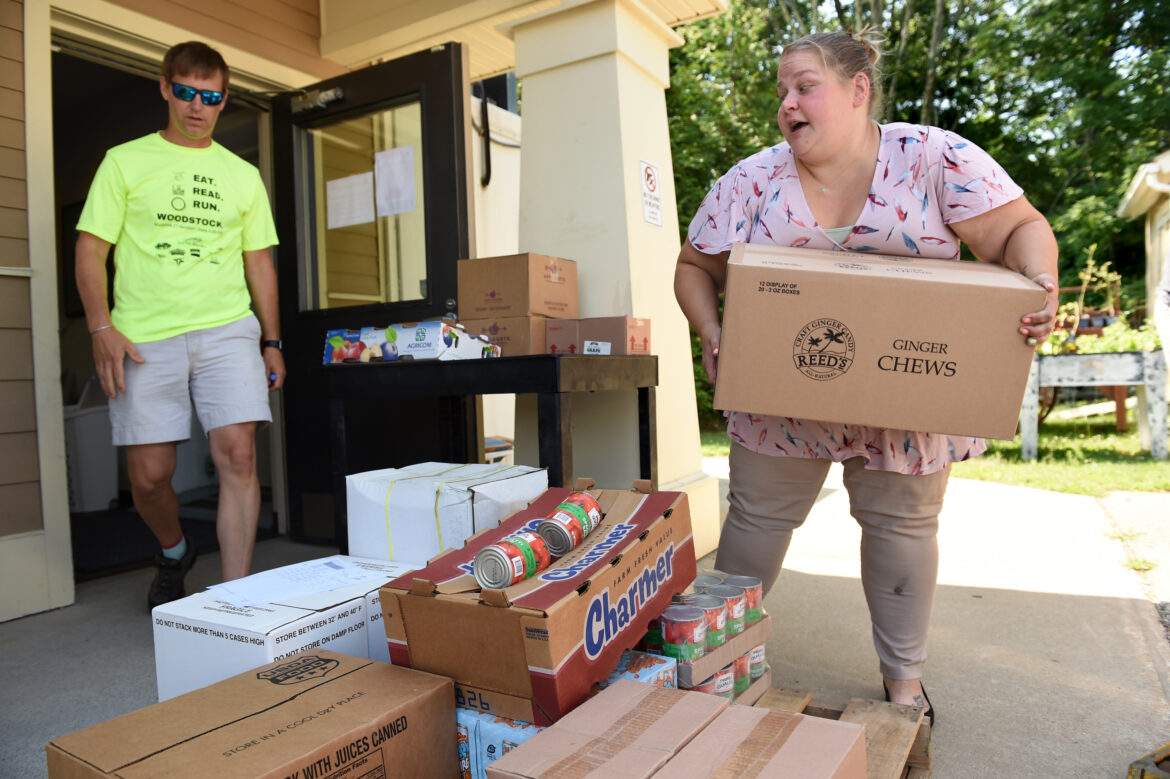An abundance of healthy selections. Clearly marked nutrition labeling. The ability to pre-order. Fresh produce and meat.
The 364,040 people in Connecticut who face hunger—one in every 10 residents—are increasingly likely to find these and other grocery store-like features at their local food pantries.
Throughout the state, more appealing ways to address food insecurity—a plight characterized by insufficient access to nutritious food on a regular basis—are replacing the former stereotypical food pantries housed in dark, closet-sized spaces in out-of-the-way places frequently lined with cans of otherwise unwanted food and opened irregularly depending on the availability of volunteers.
“We’re trying to put some humanity behind the numbers and to recognize that every one of those numbers is an individual and is having a tough time,” said Katie Martin, former executive director for Foodshare Institute for Hunger Research & Solutions, a resource for food banks and community partners.
For many Connecticut residents, facing the pandemic without steady employment or the availability of free or reduced school meals meant crossing the threshold into food insecurity. Compared to 2018, 2020 food insecurity levels were elevated in every county in Connecticut–from 12.8% of the population in Tolland to 16.2% in New Haven to 17% in New London, according to a report by the Connecticut Office of Legislative Research. But even during the darkest days of the pandemic, new and more effective ways of responding to food insecurity were taking hold across the state.
Innovations

Julieth Callejas, interim executive director, End Hunger Connecticut!
“During COVID, working-class residents were one or two checks away from becoming food insecure,” said Julieth Callejas, interim executive director of End Hunger Connecticut! (EHC!), a statewide organization. Callejas says she and her professional peers discovered that food pantries weren’t being utilized as efficiently as they could be. So EHC! stepped up, working harder and smarter to meet the growing demand in various ways.
During spring 2021, in conjunction with local food pantries, EHC! launched the Full Shelf Initiative, establishing a buying group to secure pricing contracts for the estimated 30% of food needs not covered by the existing food bank or donation process. “It’s food pantries helping pantries by networking and buying in bulk for reduced prices,” Callejas said. “There are about 800 pantries across Connecticut. We’ve connected to over 200 of them.”
In June, with funding from the American Rescue Plan, EHC! entered into a new partnership with the Connecticut Department of Agriculture that expanded its CT Fresh Match program, which allows Connecticut farmers market outlets to double customer purchases made via Supplemental Nutrition Assistance Program (SNAP) benefits. As of June, 28 Connecticut farmers markets, farm stands, and mobile markets were participating in CT Fresh Match, many within reach of residents who need help most. In Bridgeport, for instance, seven farmers markets that are part of the community’s Farmers Market Collaborative are in neighborhoods deemed “nutritionally insecure.”
Increasingly, meeting residents where they are is a concept that extends beyond neighborhoods.
Meeting People Where They Are
In May, Hartford Hospital held a ribbon-cutting for its Food as Medicine center. Intended to look like a grocery store, the center offers patients access to healthy food items, free of charge, prescribed by their care providers.
Dr. Jessica Hsieh Mullins, director of gynecology at Hartford Hospital, said that in November 2019, the hospital began screening prenatal patients for food insecurity. Initially, about 25% were determined to be food insecure.
“As the pandemic progressed, the percentages increased,” Mullins said. “Now we’re at 50 percent.”
Mullins says food insecurity correlates with inappropriate weight gain during pregnancy, a risk factor for gestational diabetes and other complications that can adversely affect maternal health outcomes.

Cloe Poisson Photo.
TEEG uses a client-centered approach at their food pantry called SWAP (Supporting Wellness at Pantries) to address food insecurity. They categorize food on shelves according to its nutritional value to help clients make healthy choices. The most healthy choices are on the top shelf.
As part of a pilot program involving 20 patients, participants who screen as food insecure have weekly access to the hospital-based food pantry and 1-on-1 counseling with an onsite nutritionist. The department saw a 50% reduction in inappropriate weight gain among participants who received nutritional counseling, and that was before the availability of the onsite food pantry that offers healthy food choices.
“It’s really encouraging,” said Mullins, who adds that they hope to eventually offer this service to all patients who qualify for it.
A Dignified Approach
This client-centered approach to addressing food insecurity is gaining considerable traction throughout the state. Martin said that Connecticut Foodshare surveyed state residents last year. “A lot of people say they don’t want to rely on others for help. They would feel embarrassed to ask,” she said. Foodshare workers use this information as they develop ways to make the process more dignified and share these strategies with their network, which includes multiple partner sites throughout Greater Hartford.

Cloe Poisson Photo.
Chelsea French, TEEG’s community program manager, stocks shelves. Carl Asikainen, food systems coordinator, and volunteer Mike Kingman, help sort the food delivery.
Promoting client choice is at the heart of this strategy. Rather than prebagged food, an increasing number of food pantries are offering options on shelves that resemble those in a grocery store, said Martin, who launched a new consulting organization, More than Food Consulting, LLC in August.
How the shelves are organized is critical. Using a research-based tactic called SWAP (Supporting Wellness at Pantries), food is ranked nutritionally based on saturated fat, sodium and sugar and is readily marked with red, yellow and green labels. Martin said that grading food on its health value is just part of the process. “We’re also putting more energy into asking people for their cultural food preferences,” she said.
All these efforts are making the process more “transformational rather than transactional,” Martin said. She points to TEEG (Thompson Ecumenical Empowerment Group, Inc.), a nonprofit social service agency in North Grosvenordale, as having embraced this model.
The nonprofit offers services for families in need, including a diaper bank and fuel and energy assistance. TEEG Executive Director Anne Miller says staff members look for opportunities to support clients in as many ways as possible. “When the community market is open, we have a case manager greeting people, signing them in,” she said. “They might say, ‘I know you have three children; would you be interested in our youth programs?’”
The three TEEG-operated community markets that Miller references used to be called food pantries. She says the newer versions, which apply the SWAP method of categorizing food, consistently offer frozen meat, fresh produce, milk and other dairy products. TEEG also makes home deliveries to clients who can’t get to the market.
Miller sees the food program as a way to reduce food insecurity and establish a trusting connection with community members who could benefit from assistance in other ways. “We are the conduit, the pipeline,” Miller said. “It used to be neighbor to neighbor. We don’t know our neighbors anymore.”

The mention here about making food pantries a dignified experiences is important. There are a few things that could be done to make it feel more comfortable. Things like letting people apply from the privacy of their home, o asking for food online ahead of time so they can pick it and spend less time waiting, and so on.